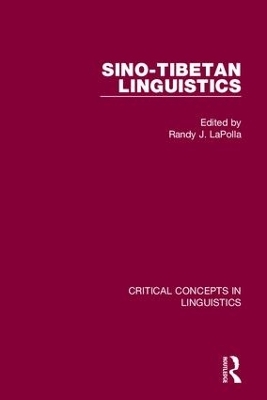
Sino-Tibetan Linguistics
Routledge
978-0-415-57739-7 (ISBN)
The Sino-Tibetan languages form the largest language family in the world in terms of native speakers, of whom there are some 1.4 billion spread across East Asia, Southeast Asia and parts of South Asia. The family consists of two branches: Sinitic, consisting of the Chinese languages (including Cantonese and Hakka), and Tibeto-Burman, which as well as Tibetan and Burmese includes several hundred further languages spoken from the Tibetan plateau in the north to the Malay peninsula in the south, and from northern Pakistan in the west to northeastern Vietnam in the east.
This four-volume collection focuses on journal articles, with a small selection of seminal contributions from the book literature. Although the majority of the material is drawn from sources published in the past thirty years, some classic pieces are included; for example, a paper on Tibetan initials by F. K. Li which was published in 1933 and has never been surpassed.
This new Major Work from Routledge is a set which someone new to the field of Sino-Tibetan studies could go to in order to get a general idea of the development and current state of the art of the subject, as aside from the seminal articles, there are introductions by the Editor that contextualise the articles and also cite relevant literature that built on the seminal articles. A veteran could also go to these volumes as an easy source for the most frequently cited articles in the field.
Randy J. LaPolla is Professor of Linguistics amd Multilingual Studies, Nanyang Technological University, Singapore.
CONTENTS
Volume I: Establishing the Relationships
Acknowledgements
Chronological table of reprinted articles and chapters
Preface
Introduction to Volume I: Establishing the relationships
Part 1. Establishing the relationships
1 Languages and dialects of China
Fang-Kuei Li
2 Where it all began: memories of Robert Shafer and the "Sino-Tibetan Linguistics Project", Berkeley 1939–40
Paul K. Benedict
3 Thai, Kadai, and Indonesian: a new alignment in southeastern Asia
Paul K. Benedict
4 Classification of the Sino-Tibetan languages
Robert Shafer
5 Notes on Fang–Kuei Li’s ‘Languages and dialects of China’
James A. Matisoff
6 Sino-Tibetan: another look
Paul K. Benedict
7 On megalocomparison
James A. Matisoff
8 Comment on Matisoff’s comparison between Greenberg and Benedict
Paul K. Benedict
9 Sino-Tibetan linguistics: present state and future prospects
James A. Matisoff
10 The Sal languages
Robbins Burling
11 On the evidence for the relationship Kiranti-Rung
Karen H. Ebert
12 The linguistic position of Tani (Mirish) in Tibeto-Burman: a lexical assessment
Jackson T.-S. Sun
Part 2. Sino-Tibetan historical reconstruction
13 The number "a hundred" in Sino-Tibetan
J. Przyluski and G. H. Luce
14 Concerning the variation of final consonants in the word families of Tibetan, Kachin, and Chinese
Stuart N. Wolfenden
15 Variable finals in Proto-Sino-Tibetan
Randy J. LaPolla
16 A comparative study of the Chinese, Tibetan, and Burmese vowel systems
Hwang-cherng Gong
Volume II: Language contact and areal features
Introduction to Volume II: Language contact and areal features
17 The topography of certain phonetic and morphological characteristics of South East Asian languages
Eugénie J. A. Henderson
18 Language diffusion on the Asian continent: problems of typological diversity in Sino-Tibetan
Mantaro J. Hashimoto
19 Origin of the East Asian linguistic structure: latitudinal transitions and longitudinal developments of East and Southeast Asian languages
Mantaro J. Hashimoto
20 Some old Chinese loan words in the Tai languages
Li Fang-Kuei
21 Sino-Tai
Fang-Kuei Li
22 Southern Chinese dialects: the Tai connection
Oi-kan Yue Hashimoto
23 The Austroasiatics in ancient South China: some lexical evidence
Jerry Norman and Tsu-lin Mei
24 The linguistic position of Rong (Lepcha)
R. A. D. Forrest
25 On the place of Lepcha in Sino-Tibetan: a lexical comparison
Nicholas C. Bodman
26 Language contact between related languages: Burmese influences upon Plains Chin
Theodore Stern
27 Influence of Burmese language on some other languages of Burma (writings systems and vocabulary)
Denise Bernot
28 A tentative list of Mon loan words in Burmese
Hla Pe
29 Phonological convergence between languages in contact: Mon-Khmer structural borrowing in Burmese
David Bradley
30 Nissaya Burmese: a case of systematic adaptation to a foreign grammar and syntax
John Okell
31 North-East India as a linguistic area
Dipankar Moral
32 Indo-Aryan and Tibeto-Burman contact: as seen through Nepali and Newari verb tenses
Edward H. Bendix
33 Languages in contact in Western China
Charles N. Li
34 Altaic elements in the Línxià dialect: contact-induced change on the Yellow River Plateau
Arienne M. Dwyer
Volume III: Sinitic
Introduction to Volume III: Sinitic
Part 1. Archaic/Old Chinese and Ancient/Middle Chinese
35 Word families in Chinese
Bernhard Karlgren
36 Cognate words in the Chinese phonetic series
Bernhard Karlgren
37 Derivation by tone-change in Classical Chinese
G. B. Downer
38 Tones and prosody in Middle Chinese and the origin of the rising tone
Mei Tsu-lin
39 Some new hypotheses concerning word families in Chinese
E. G. Pulleyblank
40 Some further evidence regarding Old Chinese -s and its time of disappearance
E. G. Pulleyblank
41 Fangyan gleanings
W. South Coblin
42 A new approach to Chinese historical linguistics
Jerry L. Norman and W. South Coblin
43 A case of radical ambiguity in Old Chinese: some notes toward a discourse-based grammar
Derek D. Herforth
44 The adposition yi and word order in Classical Chinese
Chaofen Sun
Part 2. Modern varieties
45 A system of tone "letters"
Yuen-Ren Chao
46 The non-uniqueness of phonemic solutions of phonetic systems
Yuen-Ren Chao
47 Peiping phonology
Charles F. Hockett
48 The zero initial and the zero syllabic
Fang-Kuei Li
49 A systemic interpretation of Peking syllable finals
M. A. K. Halliday
50 Tonal development in Min
Jerry Norman
51 Hakka in Wellentheorie perspective
Mantaro J. Hashimoto
52 The lexicon in syntactic change: lexical diffusion in Chinese syntax
Anne Yue-Hashimoto
53 Arguments against "subject" and "direct object" as viable concepts in Chinese
Randy J. LaPolla
Volume IV: Tibeto-Burman
Acknowledgements
Introduction to Volume IV: Tibeto-Burman
54 Certain phonetic influences of the Tibetan prefixes upon the root initials
Fang-Kuei Li
55 Notes on Tibetan verbal morphology
W. South Coblin
56 Alternation of final vowel with final dental nasal or plosive in Tibetan
Walter Simon
57 The addition of final stops in the history of Maru (Tibeto-Burman)
Robbins Burling
58 Colloquial Chin as a pronominalized language
Eugénie J. A. Henderson
59 Pronominal verb morphology in Tibeto-Burman
Jim Bauman
60 On the dating and nature of verb agreement in Tibeto-Burman
Randy J. LaPolla
61 Parallel grammaticalizations in Tibeto-Burman languages: evidence of Sapir’s ‘drift’
Randy J. LaPolla
62 Verb agreement in Classical Newar and Modern Newar dialects
Tej R. Kansakar
63 The historical status of the conjunct/disjunct pattern in Tibeto-Burman
Scott DeLancey
64 Lahu nominalization, relativization, and genitivization
James A. Matisoff
65 A linguistic image of nature: the Burmese numerative classifier system
Alton L. Becker
66 Tonogenesis in Southeast Asia
James A. Matisoff
Index
| Erscheint lt. Verlag | 22.10.2018 |
|---|---|
| Reihe/Serie | Critical Concepts in Linguistics |
| Zusatzinfo | 113 Tables, black and white; 37 Halftones, black and white |
| Verlagsort | London |
| Sprache | englisch |
| Maße | 156 x 234 mm |
| Gewicht | 453 g |
| Themenwelt | Schulbuch / Wörterbuch ► Wörterbuch / Fremdsprachen |
| Geisteswissenschaften ► Sprach- / Literaturwissenschaft ► Sprachwissenschaft | |
| ISBN-10 | 0-415-57739-X / 041557739X |
| ISBN-13 | 978-0-415-57739-7 / 9780415577397 |
| Zustand | Neuware |
| Haben Sie eine Frage zum Produkt? |
aus dem Bereich


